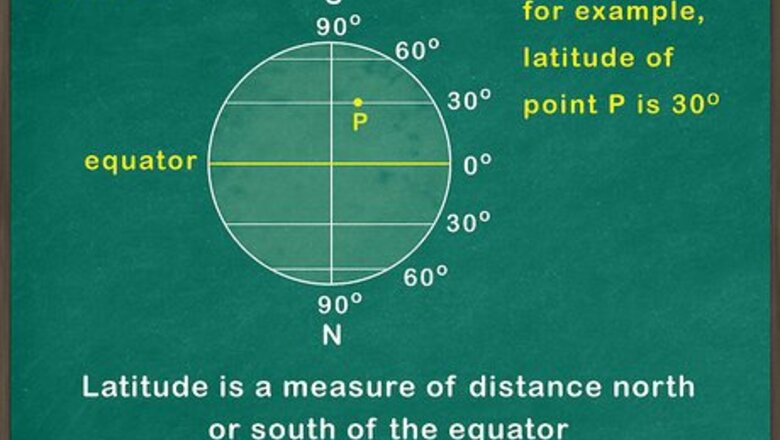
views
- Locate the evenly-spaced horizontal (latitude) and vertical (longitude) lines on a map. The coordinates are along the edges of the map.
- Find the location you're measuring on the map. Use a ruler to draw vertical and horizontal lines from the location to the edges of the map.
- Write down the vertical coordinate, which is latitude, and the horizontal coordinate, which is longitude.
Understanding Latitude and Longitude
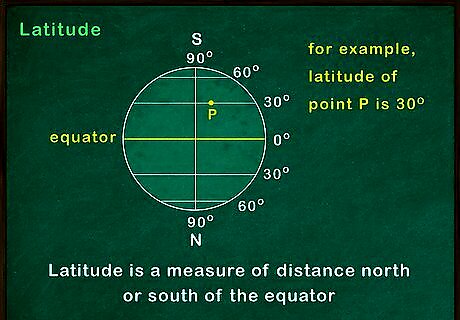
Get familiar with the concept of latitude. Latitude is a measure of distance north or south of the equator, which is an imaginary horizontal line around the exact mid-point of the earth between the 2 poles. The earth is divided up into 180 latitude lines on either side of the equator, called parallels. These parallels run horizontally around the earth, parallel to the equator. 90 of them are north of the equator, while the other 90 are south of it.
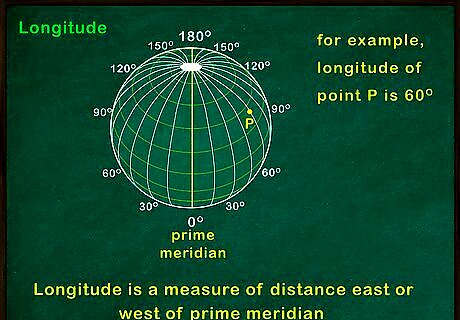
Learn the definition of longitude. Longitude is a measure of distance east or west of an imaginary vertical line that runs down the outside of the globe from the North Pole to the South Pole, called the prime meridian. The prime meridian could have been chosen to be anywhere, but there is an international agreement that the meridian that runs through Greenwich, England, is considered the official prime meridian, with 0° longitude. Longitude lines are a series of vertical lines from North Pole to the South Pole, also called meridians because every place touched by the same meridian have midday at the same time. There are 360 meridians on either side of the prime meridian, with 180 of them located east of the prime meridian, and the other 180 located to the west of it. The meridian on the opposite side of the earth from the prime meridian is called the anti-meridian.
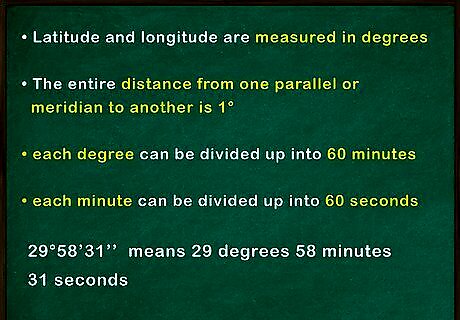
Examine the units of measurement used for latitude and longitude. The measurements of latitude and longitude are usually expressed in degrees (°), minutes (′), or seconds (″). The entire distance from one parallel to another or one meridian to another is 1°. To produce even more accurate measurements, each degree can be further divided up into 60 minutes, and each minute into 60 seconds (for a total of 3,600 seconds per degree). Latitude and longitude are measured in degrees rather than absolute units of measurement (such as miles or kilometers) because the Earth is spherical. While the distance between degrees of latitude is constant (60 nautical miles or 111.12 km), the Earth’s shape causes the distance between degrees of longitude to decrease as you approach the poles.
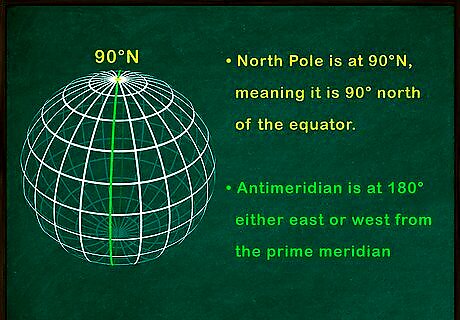
Measure latitude and longitude relative to the 0 point. When measuring latitude in either direction, the equator is considered the starting point, at 0° latitude. Likewise, the prime meridian is the starting point for measures of longitude, representing 0° longitude. Every measure of latitude or longitude is expressed in terms of how far it is from the origin point in either direction. For example, the North Pole is at 90°N, meaning it is 90° north of the equator. The antimeridian is at 180° either east or west from the prime meridian. The Great Sphinx of Giza in Egypt is located at 29°58′31″N, 31°8′15″E. This means it is just under 30° north of the equator in latitude, and about 31° east of the prime meridian in longitude.
Determining Latitude and Longitude Coordinates on a Map
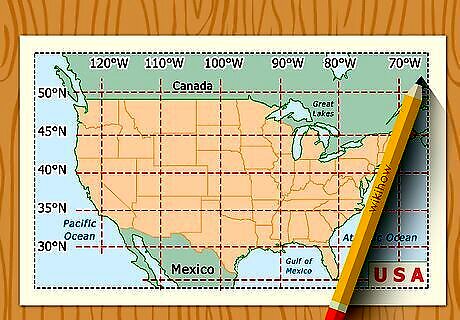
Find a map with latitude and longitude lines. Not all maps indicate latitude and longitude. You are most likely to find them on maps of large areas, such as atlas maps, or on smaller maps that are designed to reflect the terrain extremely accurately, such as topographic maps. If you are in the US, detailed topographic maps of most regions are available through the US Geological Survey.
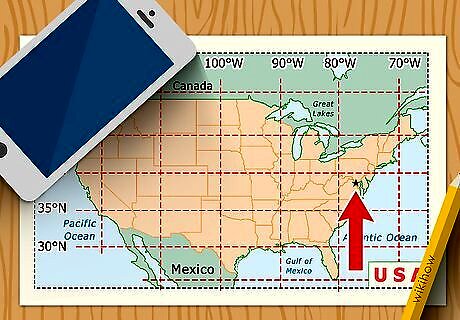
Pinpoint the location you are interested in. Take look at the map, and locate the feature or area for which you would like to know the coordinates. Mark the exact spot you are interested in with a pin or a pencil mark.

Locate the latitude and longitude markers. Latitude is indicated on a map by a series of evenly-spaced horizontal lines running from one side of the map to the other, while longitude is indicated by a series of evenly-spaced vertical lines running from top to bottom. Look for numbers along the edges of the map giving coordinates for each line. These numbers are called “graticules.” Latitude graticules are marked along the east and west edges of the map. Longitude graticules are marked on the north and south edges. Depending on the scale of your map, the graticules may mark fractions of degrees rather than whole degrees. For instance, there may be a Graticule marked at every minute within a degree instead of every degree (e.g., 32°0′, 32°1′, and so on). The map should also indicate where the latitude and longitude depicted are relative to the equator and prime meridian, respectively (e.g., North or South, East or West). Take care not to confuse the latitude and longitude lines with UTM lines, another type of grid coordinate system often found on maps. UTM numbers are usually marked in a smaller text (and without degree symbols) along the edges of the map, and UTM gridlines may be marked in a different colour from latitude and longitude lines.
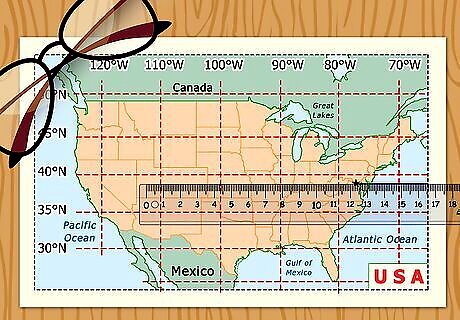
Use a ruler to mark the latitude of your point. Take a ruler and a pencil and mark a level horizontal line from your point to the nearest east or west edge of the map. Make sure your line is parallel to the nearest latitude line on the map.
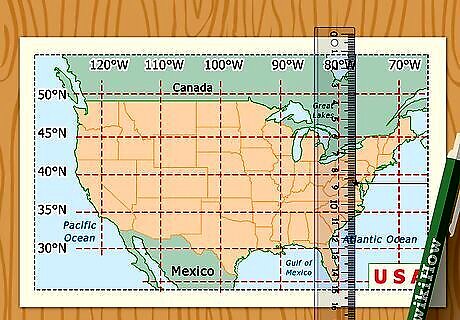
Draw another line to mark the longitude of the point. Starting from the same point, use the ruler and pencil to draw a straight vertical line to the nearest north or south edge of the map. Make sure your line is parallel to the closest longitude line.
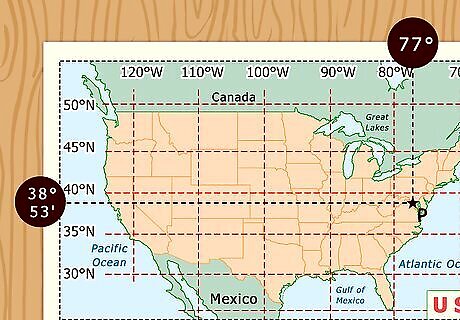
Estimate the latitude and longitude of your point using the graticules. Depending on the scale of the map, you may be able to estimate the coordinates of your point down to the second. Look at where your latitude and longitude lines intersect the coordinate lines on the edge of the map, and estimate the coordinates by their position relative to the closest graticules. If your map shows seconds, find the second closest to where each line intersects the latitude or longitude scale at the edge of the map. For example, if your latitude line falls about 5″ above the 32°20′N line, your point is at a latitude of approximately 32°20′5″N. If your map shows minutes, but not seconds, then you can estimate your latitude or longitude to within 6 seconds by dividing the space between each graticule into 10ths. If your longitude line falls about 2/10 to the left of the 120°14′E line, then the longitude is roughly 120°14′12″E.
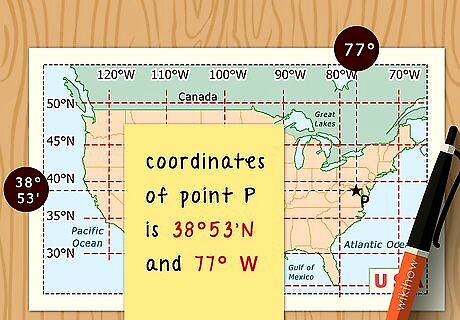
Put your measurements together to determine the coordinates. Geographic coordinates are the place where the latitude and longitude lines converge on a single point. Look at the numbers you got for the latitude and longitude of your point, and put them together (e.g., 32°20′5″N, 120°14′12″E).



















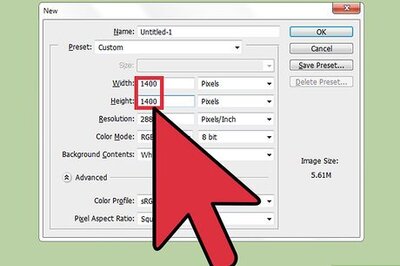
Comments
0 comment